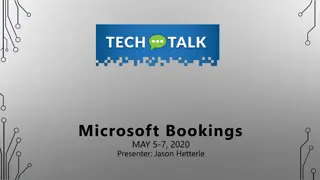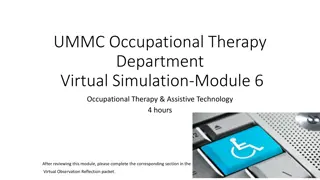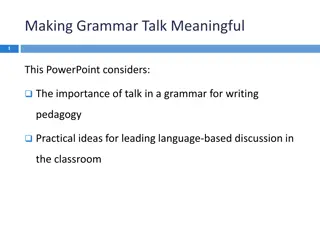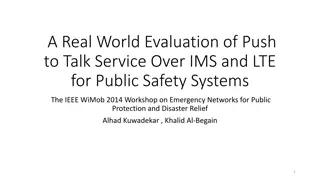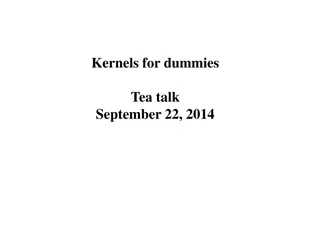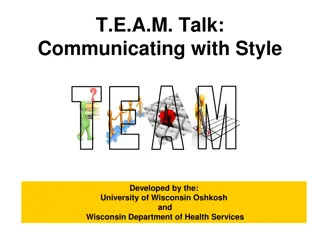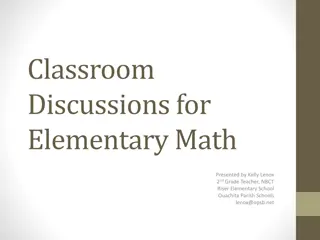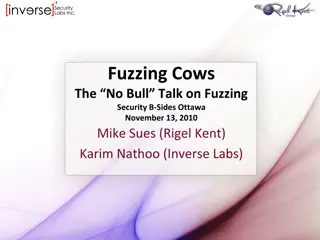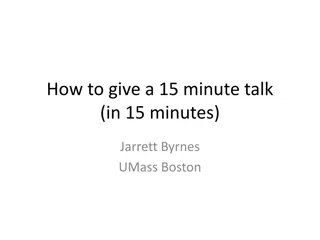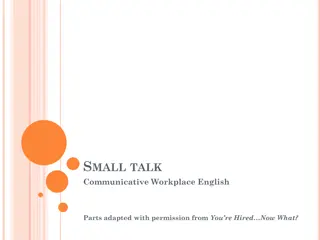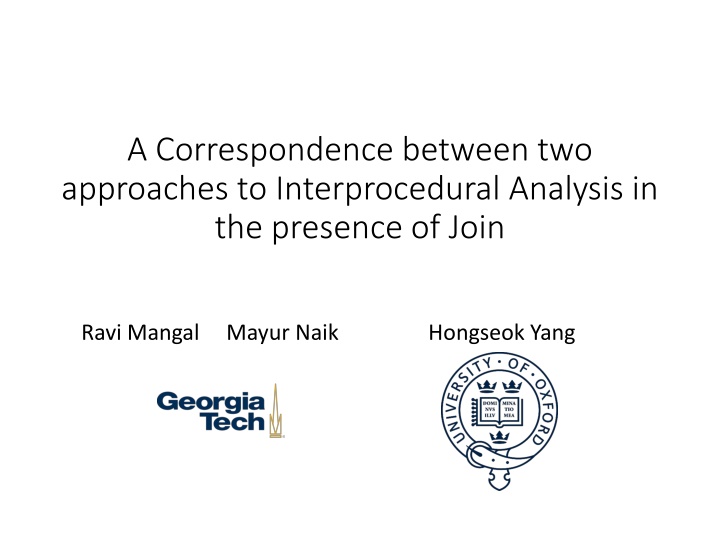
Comparing Approaches to Interprocedural Analysis in Software Development
Explore the landscape of interprocedural analysis with a comparison of different approaches such as context-sensitive, context-insensitive, callstring-based analysis, and summary-based analysis. Delve into the cost, precision, and methodologies used in each approach for better understanding and optimization of software development processes.
Download Presentation

Please find below an Image/Link to download the presentation.
The content on the website is provided AS IS for your information and personal use only. It may not be sold, licensed, or shared on other websites without obtaining consent from the author. If you encounter any issues during the download, it is possible that the publisher has removed the file from their server.
You are allowed to download the files provided on this website for personal or commercial use, subject to the condition that they are used lawfully. All files are the property of their respective owners.
The content on the website is provided AS IS for your information and personal use only. It may not be sold, licensed, or shared on other websites without obtaining consent from the author.
E N D
Presentation Transcript
A Correspondence between two approaches to Interprocedural Analysis in the presence of Join Ravi Mangal Mayur Naik Hongseok Yang
Landscape of Procedural Analyses Inter-Procedural Context-Sensitive (Callstrings, Summaries, ) Cost Context- Insensitive Intra- Procedural Precision ESOP 2014 2
Context-Insensitive Analysis 1: void main(){ main 2: foo(); 3: . foo(); foo 4: . foo(); 5: } 6: void foo(){ 7: bar(); 8: } bar 0-CFA ESOP 2014 3
Inter-Procedural Analysis Landscape Cost 0CFA Precision ESOP 2014 4
Callstring-based Analysis (1CFA) 1: void main(){ main 2: foo(); 3: . foo(); 4: . foo(); 2:foo 3:foo 4:foo 5: } 6: void foo(){ 7: bar(); 8: } 7:bar 1-CFA ESOP 2014 5
Inter-Procedural Analysis Landscape Cost 1CFA 0CFA Precision ESOP 2014 6
Callstring-based Analysis (2CFA) 1: void main(){ main 2: foo(); 3: . foo(); 4: . foo(); 4:foo 2:foo 3:foo 5: } 6: void foo(){ 7: bar(); 7,2:bar 7,4:bar 7,3:bar 8: } 2-CFA ESOP 2014 7
Inter-Procedural Analysis Landscape Shivers [1988], bddbddb [2004] , Paddle [2004], Doop [2009], Cost -CFA 2CFA 1CFA 0CFA Precision ESOP 2014 8
Summary-based Analysis (SBA) 1: void main(){ 1 main 2: foo(); . foo(); . foo(); 1 3: 4: 2 1:foo 2:foo 5: } 6: void foo(){ 3 7: 8: } bar(); 3:bar Summary-based ESOP 2014 9
Inter-Procedural Analysis Landscape Sharir-Pnueli [1981], Reps et al. [1995], SBA Cost Precision ESOP 2014 10
Summary-based Analysis (SBA) 1: void main(){ 1: void main(){ 1 1 2: if(*) 2: if(*) 3: s1; 3: s1; 2 2 4: else 4: else 5: s2; 5: s2; 3 3 4 = 2 3 2 3 6: } 6: } Non-disjunctive summary-based (ND-SBA) Disjunctive summary-based (D-SBA) ESOP 2014 11
Inter-Procedural Analysis Landscape SLAM [2000] TVLA [2004], SpaceInvader [2008], D-SBA Partially D-SBA SAFE [2008] ND-SBA Sharir- Pnueli [1981] Yes ? ? ? = ? ? ? ? ? Distributive? Cost -CFA No 2CFA Grove-Chambers [2001] conjecture 1CFA Our Result 0CFA Precision ESOP 2014 12
Our Contributions Proved -CFA = SBA for non-distributive analyses with finite domains. Generalized Sharir-Pnueli s 1981 result and resolved 2001 conjecture by Grove-Chambers. Empirically observed the precision of -CFA via SBA for pointer analysis and improved over existing k-CFA approaches. ESOP 2014 13
New Inter-Procedural Analysis Landscape D-SBA Partially D-SBA ND-SBA Cost -CFA 2CFA 1CFA 0CFA Precision ESOP 2014 14
Proof Challenges Challenge 1: Unused summaries in SBA fixpoint solution. Challenge 2: Non-monotonicity of SBA. ESOP 2014 15
Proof Challenges (1) 1: int x; -0 0+ 2: void main(){ [x: ] 3: x = 0; [x:0] 0 - + 4: while(*){ [x:0] [x:0+] 5: inc(x); [x:+] 6: } Sign Abstract Domain Unused summary in the fixpoint solution 7: } 8: void inc(int x){ [x:0] [x:0+] 9: x++; [x:+] [x:+] 10: } ESOP 2014 16
Proof Challenges (1) Challenge 1: Unused summaries in SBA fixpoint solution. Solution: Garbage collection on results computed by SBA. ESOP 2014 17
Proof Challenges (2) 1: int x; ? ? ? ? ? ? -0 0+ 2: void main(){ 3: 0 - + 4: [x:0+] [x:0] 5: inc(x); [x: ] [x:+] [x: ] 6: Sign Abstract Domain 7: } 8: void inc(int x){ [x:0] [x:0] [x:0+] 9: x++; [x:+] [x:+] 10: } Non-monotonicity of SBA ESOP 2014 18
Proof Challenges (2) Challenge 2: Non-monotonicity of SBA. Solution: Fixpoint of a non-monotone function is approximated by pre-fixpoint of the function. ESOP 2014 19
Experimental Motivation Existing k-CFA approaches scale to low k values. Correspondence result allows us to simulate the effect of -CFA via SBA. Empirically study the scalability of SBA and the precision of -CFA. ESOP 2014 20
Experimental Setup 3 client analyses: call graph reachability, downcast safety, monomorphic callsite inference. All clients based on an underlying interprocedural pointer analysis for Java bytecode. Implemented using Chord. 10 benchmarks from Dacapo suite. ESOP 2014 21
Pointer Analysis Clients Downcast safety: Downcast is safe if the object to which it is applied is a subtype of the target type. 1: void main(){ 2: Shape s = new Square(); 1: void main(){ 2: Shape s = new Circle(); 3: Circle c = (Circle) s; 3: Circle c = (Circle) s; 4: } 4: } Shape Circle Square ESOP 2014 22
Pointer Analysis Clients Call graph reachability: Pairwise reachability between program functions. 1: void main(){ 2: foo(); reach(foo,bar) 3: taz(); 4: } reach(foo,taz) 5: void foo(){ 6: bar(); 7: } ESOP 2014 23
Pointer Analysis Clients Monomorphic callsite inference: Dynamically dispatched callsite with single target method. 1: void main(){ 1: void main(){ 2: Shape s; 2: Circle c = new Circle(); 3: if(*){ 3: c.area(); 4: s = new Circle(); 4: } 5: }else{ 6: s = new Square(); 7: } 8: s.area(); 9: } ESOP 2014 24
Benchmarks name antlr avrora bloat chart hsqldb luindex lusearch pmd sunflow xalan # functions 7.2k 6.9k 9.1k 11.4k 10.2k 7.7k 7.6k 9.1k 13.3k 6.7k bytecode (KB) 467 423 586 778 670 487 477 578 934 417 KLOC 224 214 258 366 322 237 231 247 419 208 ESOP 2014 25
Question 1 Given that k-CFA does not scale, does SBA even scale? ESOP 2014 26
Running Time of Pointer Analysis 300 On average, 2CFA is 3x-5x slower than SBA. 250 200 time (minutes) 150 2CFA SBA 100 50 0 ESOP 2014 27
Different Contexts Per Method 60 On average, 2CFA computes 4x-7x more contexts than SBA. 50 # of contexts per method 40 30 2CFA SBA 20 10 0 ESOP 2014 28
Question 2 What is the precision gain from using -CFA compared to k-CFA? ESOP 2014 29
Downcast Safety 100 On average, SBA proves 12% more queries than 2CFA. 80 % proven queries 60 2CFA 40 SBA 20 0 ESOP 2014 30
Call Graph Reachability 100 On average, SBA call graph has: 3.3% fewer functions, 4.7% fewer edges, 15% fewer pairwise reachable functions than 2CFA call graph. On average, SBA proves 9% more queries than 2CFA. 80 % proven queries 60 2CFA 40 SBA 20 0 ESOP 2014 31
Monomorphic Call Site Inference 100 On average, SBA proves 0.6% more queries than 2CFA. 80 % proven queries 60 2CFA 40 SBA 20 0 ESOP 2014 32
Experimental Results Summary For our clients: SBA scales better than k-CFA; analyzes each method in fewer contexts. SBA is more precise than 2CFA; greater benefit for harder queries. General comments: Scalability of SBA depends on the richness of the abstract domain. Callstring length just one of the factors affecting analysis precision. ESOP 2014 33
Open Question k-Object Sensitive Analyses: Proposed by Milanova et al. [2002], uses allocation site of receiver objects to distinguish calling contexts. Empirically shown to be more precise and scalable than k-CFA for similar k values. Theoretically incomparable to k-CFA. Theoretical and empirical comparison with SBA? ESOP 2014 34
Inter-Procedural Analysis Landscape D-SBA Partially D-SBA ND-SBA Cost -CFA -OBJ 2CFA 3OBJ 1CFA 2OBJ 0CFA 1OBJ Precision ESOP 2014 35
Conclusion Proved that -CFA = SBA for non-disjunctive, non- distributive analyses and generalized Sharir-Pnueli s result. Developed new proof techniques for garbage collection of summaries and approximating fixpoints of non-monotonic analyses. Empirically observed the precision of -CFA via SBA, and found SBA is more scalable in practice. ESOP 2014 36



